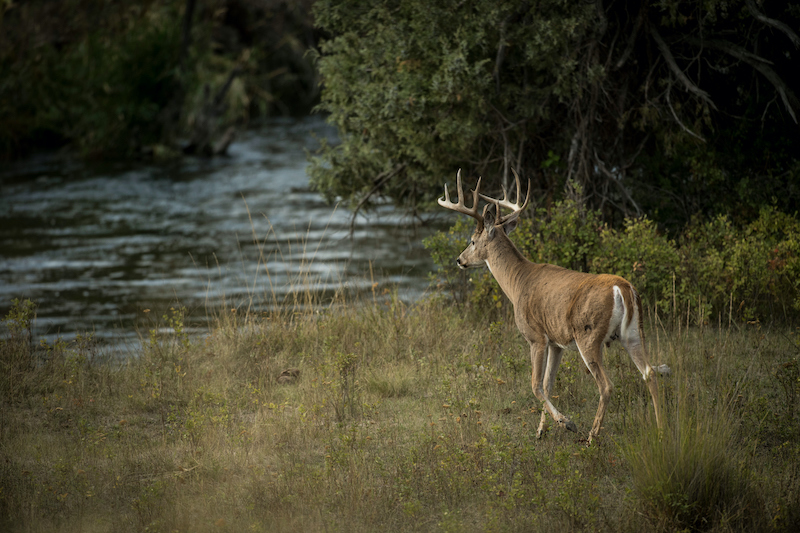Whitetails are the most resilient and adaptable members of the deer family. Although their range sprawls across much of the Lower 48 and into Canada, hunting them requires varying tactics because whitetails forever adapt to their surroundings. The following tips and tricks will point you in the right direction.
When you think about bowhunting big-woods whitetails, you likely picture monotonous stands of mature timber in the Northeast or Upper Great Lakes states. Look closer while studying satellite and topographic maps. You’ll soon realize the landscape’s diversity.
Deer are edge creatures, so seek areas with active timber management. Clear-cuts and select cuts open the forest canopy, allowing sunlight to generate new browse, foliage and underbrush, which are ideal foods for whitetails. Cuts 2 to 5 years old offer food and bedding cover because of new growth and high stem counts in these places.
If you can’t find any recent cuts, focus on trees that produce mast crops. White oaks, for example, drop acorns in early fall and quickly become a whitetail’s preferred food source. Do some in-season scouting to find oaks dropping acorns, and focus your hunting efforts there.
Corn and soybean fields often dominate the heartland, providing Midwest whitetails plenty of food. Identify destination food sources, and then pinpoint likely nearby bedding areas where whitetails spend most of their daylight hours. Strategically place a treestand or ground blind between the food source and bedding area to intercept deer.
That sounds simple, but food sources constantly change in farm country. Crops rotate by season, so last year’s intel won’t always apply to the current season. Plus, wind direction typically dictates a buck’s bedding location, which makes it tricky to sneak within 150 to 200 yards of them. Craft a mobile strategy with plenty of stand locations scouted before opening day. That provides an effective way to hunt undisturbed sites throughout the season until you capitalize on a buck that never knew it was being hunted.
Pine stands planted in perfect rows beside thick swamps often describe the South’s whitetail country. Swamp edges offer ideal bedding habitat. Spooked deer take a few bounds and find refuge with impenetrable cover. Such sites can be intimidating to bowhunt, but you can quickly eliminate areas with too much water and zero in on spots where bucks bed.
Look for elevated knobs in a swamp that give bucks a vantage point to stay dry and spot potential danger. Nearby rubs and scrapes are evidence you found a buck bedding area. Deer typically bed with the wind at their back, so keep that in mind when preseason scouting for beds. When you find one, crouch to assess the buck’s point of view. It will give you a better idea of the prevailing wind direction when a buck beds there. Plot this point on your map or GPS unit, and then find where you can hunt just-off wind of the beds to ambush the buck within 150 yards of its bedroom.

Whitetails will follow fences in otherwise open landscapes. Photo Credit: John Hafner
Open-country whitetails offer exciting bowhunts in the Dakotas, Nebraska, eastern Colorado and other places with little tree cover. Swap your treestand for a ghillie suit and binoculars to accept the challenges of spot-and-stalk bowhunting. Whitetails take cover in whatever they find in open landscapes. Shelterbelts, waterways and fencerows provide just enough cover to hide deer, so focus your glassing efforts there to spot a buck. The sparse cover and flat terrain make stalks difficult, so consider mounting a lightweight, two-dimensional decoy to your bow. This tactic is especially effective during the rut, but it can work throughout fall. Keep the wind in your face and sneak in quietly. Good kneepads will help you stalk more effectively, and prevent pokes from cactus thorns.

Whitetails frequent river bottoms in the west. Photo Credit: John Hafner
Whitetails also roam the West’s high country, but are more common in river bottoms. Cottonwoods and lush alfalfa fields flank many rivers in Idaho, Montana and Wyoming, which offer ideal deer habitat. Deer follow predictable feeding patterns during the early season, emerging from riverbottoms late in the day to graze in destination food sources for the night. During the rut, however, bucks cruise those winding riverbottoms seeking estrous does. Paddle a kayak or canoe to reach remote sections of riverbottoms where other hunters won’t go.
The Appalachian Mountains pair whitetail habitat with some of our country’s most beautiful scenery. The Appalachians’ steep terrain can make deer hunts intimidating, but topography can create predictable bedding habits. When north winds blow in a cold front from over the mountains in November, deer seek southern exposures to avoid the wind while basking in the midday sun.
By understanding bedding habits and real-time weather conditions, you can focus on high-odds hunting locations. Other terrain features, like a saddle connecting two peaks, are great places for a treestand. Rather than walking over the ridge’s highest points, deer prefer paths of least resistance. You’ll usually find a worn deer trail through saddles in steep topography.
From coast to coast, plenty of exciting whitetail hunts await. Whether you’re exploring new areas or hunting familiar sites near home, embrace whitetail country’s beautiful creations.